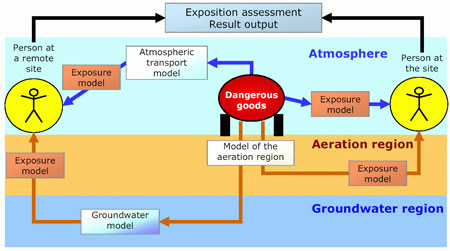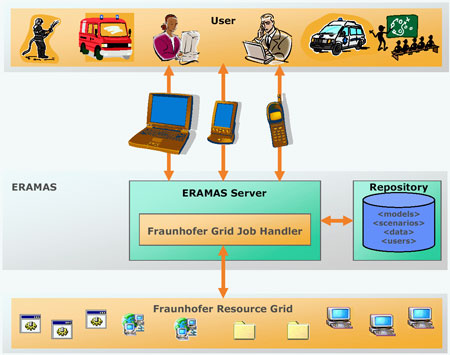
This issue in pdf Subscription Archive: Next issue: July 2005 |
|
|||||||
ERAMAS - Environmental Risk Analysis and Management Systemby Thilo Ernst, Andreas Hoheisel, Thomas Lux and Steffen Unger The aim of the ERAMAS project is to develop a Grid-based system for analysing and managing pollutant-related environmental risks. Sophisticated simulation programs are used to forecast and evaluate the dispersion of carcinogenic and chemically toxic substances in the atmosphere, the soil and the groundwater, and to calculate the risk they pose to humans. ERAMAS is a simulation-based analysis framework for calculating risks due to chemically toxic or carcinogenic substances being released, for example during accidents in industrial installations, the transport of dangerous goods or by terrorist attacks. It is designed to be applicable both for real-time emergency management and for risk mitigation activities such as simulation-aided studies concerning the design of approval procedures or emergency plans. Figure 1 shows an overview of the simulation models involved in ERAMAS regarding various transportation paths for pollutants in the atmosphere and the soil. In the environmental simulation domain, this is a typical scenario; nevertheless, integrating and coupling even a small number of heterogeneous simulation models, and making them available to technically unskilled users, amounts to a very complex and time-consuming effort.
ERAMAS is being developed using the technology of the Fraunhofer Resource Grid (http://www.fhrg.fraunhofer.de), which simplifies the coupling of heterogeneously distributed software, hardware and data resources (see Figure 2). The Fraunhofer Resource Grid is a Grid initiative comprising five Fraunhofer institutes and funded by the German Federal Ministry of Education and Research. Its main objectives are to develop and implement a stable and robust Grid infrastructure within the Fraunhofer Gesellschaft, to integrate available resources, and to provide internal and external users with a user-friendly interface for controlling distributed applications and services on the Grid.
ERAMAS is a system with considerable resource demands. These arise not only from the inner complexity of its components, but also from complex workflows and usage scenarios in which a substantial number of component instances need to be executed, eg parameter studies. Such a system cannot be expected to run on a single workstation; parallel and distributed computing techniques are obviously necessary. However, the primary advantage of using Grid technology in ERAMAS is not the performance gain from having access to additional resources, but rather the organizational advantages in building and maintaining a distributed, highly heterogeneous simulation system. The Grid is used to organize the workflow of coupled simulations and to provide uniform access to a wide variety of hardware, software and data resources. The component abstractions offered by the Fraunhofer Resource Grid make the coupling of a wide range of models and data sources very easy - detailed knowledge of the internals of the components is no longer needed. The simulation components integrated in ERAMAS are pure command-line applications, that is, they have no graphical user interface. Specialized simulators usually originate from the research sector, where this is considered normal. However, it conflicts severely with the goals of and application scenarios envisioned for ERAMAS, which call for strong support of the less technically skilled user, such as users from on-site emergency response teams. This gap is bridged by relying on the VirtualLab platform (http://vl.nz.dlr.de/VL), which is being developed through collaboration between the German Aerospace Center (DLR) and Fraunhofer FIRST. VirtualLab contains a subsystem for dynamically generating flexible and easy-to-use Web user interfaces for command-line applications, using abstract descriptions of their input datasets. Together with its generic Web portal features (such as protected user areas that persistently store simulation runs, integrated documentation management, and Web-based administration), VirtualLab is thus able to provide a powerful Web access layer for ERAMAS. The ERAMAS system is being developed by Fraunhofer FIRST, in collaboration with Ingenieurbüro Beger für Umweltanalyse und Forschung and the Dresdner Grundwasser Consulting GmbH in Germany. The project is funded by the Arbeitsgemeinschaft industrieller Forschungseinrichtungen Otto von Guericke (AiF) in the programme Innovationskompetenz mittelständischer Unternehmen (PRO INNO). The funded ERAMAS project commenced in July 2002 and finished in October 2004, and the result is a demonstration prototype of the ERAMAS system. ERAMAS can be viewed as a pilot project that is introducing Grid- and Web-based e-science methods into the environmental simulation and risk management community, and is developing and deploying a dedicated platform for the purpose. Our aim for the future is to make ERAMAS a commercially operated service that can be used in a variety of ways, eg for advance analysis in licensing procedures or for drawing up action plans. Potential customers include chemical companies, haulage contractors and emergency services like the fire service. Another application area is analysis under real-time conditions, whether in the case of malfunctions in industrial plants, the transport of hazardous materials or terrorist attacks. Links:
Please contact: |
|||||||



